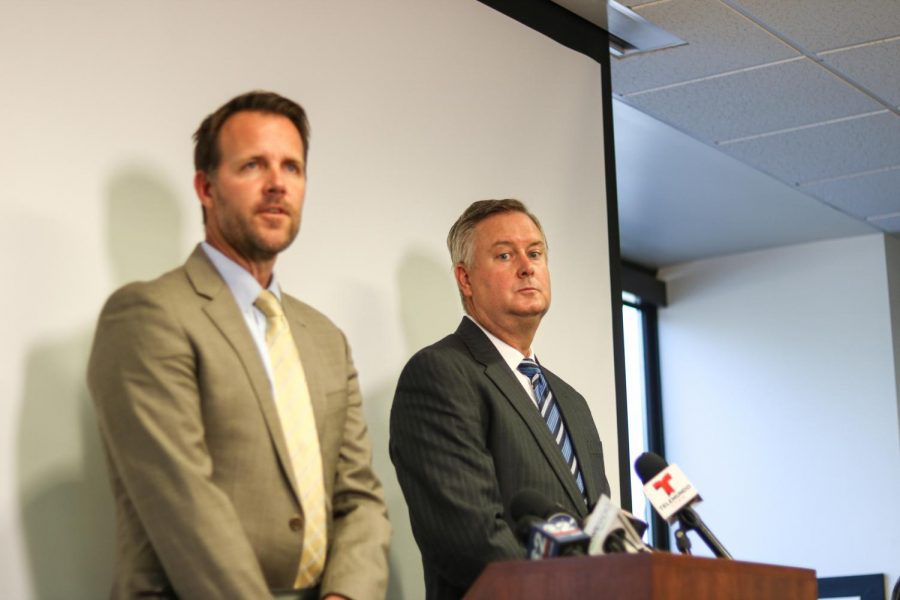Officers Involved in Killing Bernardo Palacios-Carbajal Will Not Face Charges, Family and Protesters Respond
Salt Lake police officers in riot gear charge at protesters in the streets of Salt Lake City on July 9, 2020. (Photo by Ivana Martinez | Daily Utah Chronicle)
July 10, 2020
The DA’s Decision
After the case for Bernardo Palacios-Carbajal hit his desk weeks ago, Sim Gill made his decision.
On July 9, 47 days after Palacios-Carbajal was fatally shot by Salt Lake City Police Department, District Attorney Gill released his report announcing he found the officers who killed Palacios-Carbajal justified in their use of lethal force and stated he will not prosecute the officers involved.
Gill’s decision was expedited by nearly daily protests outside his office calling for “justice for Bernardo,” and posters taped to the windows of the building.
In a press conference, at 11 a.m., Gill announced Officer’s Neil Iversen and Kevin Fortuna were scared Palacios-Carbajal would turn around and shoot them as he ran away with what they believed to be a gun and were therefore justified in shooting the 22-year old Rosepark resident 34 times in the back.
“Officer Fortuna and Officer Iversen use of deadly force satisfies Utah state law,” Gills said, “and remember Utah state law says law enforcement who use deadly force are entitled to the legal defense of justification when affecting an arrest or preventing an escape from custody.”
Gills continued to list reasons officers would be justified in using lethal force. In the footage presented by the district attorney’s office, Palacios-Carbajal is seen falling and stumbling multiple times trying to flee the scene.
Gill claimed Palacios-Carbajal held a weapon, stating multiple times throughout the press conference that the officers on scene heard metal hit the asphalt and did not shoot until they confirmed it was a gun.
“We conclude that officer Fortuna and officer Iversen believed that deadly force was necessary to prevent their death or serious bodily injury and or death or serious bodily injury of others was a reasonable belief under Utah law,” Gill said.
The Palacios Press Conference
At 2 p.m., Palacios-Carbajal’s family and attorney Nathan S. Morris and Brian Webber hosted a press conference in the First American Title conference room at Eisenberg Cutt Kendall & Olson Attorneys at Law.
The statement from the family read by Morris expressed their disappointment with Gill’s decision.
“The DA’s unwillingness to prosecute makes a mockery of the protesting public and contradicts state officials who have described the killing as ‘unlawful,’ ‘genuinely disturbing and upsetting,’ and an ‘all too familiar problem,’” Morris said.
Morris also said Gill speculated on multiple key questions and gave every benefit of the doubt to the officers, who the attorneys believe had many chances to use less than lethal force but chose not to. Webber told the press the one person who can not say what happened that day was Palacios-Carbajal.
“I feel really angry, really angry, and sick to my stomach, I feel like they just get a pat on the back for what they did,” said Frankie Palacios, Palacios-Carbajal’s brother about the district attorney’s decision.
The family spoke of Palacios-Carbajal’s kindness, how he took care of his mother who has diabetes, how he and his brother would eat lunch together every day and how on his days off, Palacios-Carbajal would spend hours in his room drawing.
Morris and Weber also announced they plan to file a lawsuit in the near future and will take civil action to ensure justice and peace for Palacios-Carbajal’s family.
“History had its eye on Mr. Gill and he did not step up and do his duty under the law, he took the easy road,” Morris said, “When he had the opportunity to do something, he shirked from the responsibility.”
THE PROTEST
At 6 p.m. protesters met outside the Salt Lake District Attorney’s Office, unsettled by the decision announced earlier in the day.
“F— Sim Gill, f— Erin Mendenhall, f— the system” was their message.
Demonstrators’ cars were quickly used to block the entrance to 500 S on both sides of the street.
Protesters chanted, “Sim Gill, you killed him too,” as they posted hundreds of posters on the district attorney’s office doors and windows.
Chalk writings in the streets were surrounded and covered by buckets of red paint. On June 27, protesters with Justice for Bernardo also painted the streets in front of the office red, but it was quickly covered up.
Red paint was splattered on the front doors and on the steps of the office — people frequently stuck their hands in wet paint and then began to mark the building with the handprints, symbolizing the blood on Sim Gill’s hands.
34 times, the number of shots fired into Palacios-Carbajal’s back, was a common chant.
After painting the streets, protesters marched around the block stopping periodically at intersections.
At 400 S. and State St., protesters took a moment to kneel in silence and remembrance of Palacios-Carbajal.
At 500 S and State St., they heard from Lorena Burciaga, a close family friend of Palacios-Carbajal, who led them in chants, yelling “Unified power” and “We are family.”
Protesters covered the cameras of surrounding media and would not let them film the events.
The crowd then returned to the district attorney’s office, where organizers announced riot police were on their way, and anyone who didn’t want to stay was welcome to leave. The majority of the crowd remained and were quickly surrounded by armed SLC officers with riot shields.
With linked arms the group marched towards police at 500 S. and State St., yelling “Officer, I don’t want to die,” Palacios-Carbajal’s last words and “I’m not scared.”
SLCPD charged at the mostly-peaceful crowd several times, using shields to forcefully shove them back, in an attempt to get them to disperse. Some protesters were injured but received assistance from fellow protesters on the sidewalks.
At the direction of organizers, protesters moved to the sidewalk and moved down State St., regrouping at the restaurant Mark of the Beastros. There, plans were made to safely disperse in groups, as circling helicopters declared the assembly unlawful and told people to leave.
“They are angry at us because we destroy their property, we are angry at them because they kill our community,” Sofia Alcala said, as they were surrounded by officers.
As protesters attempted to make their way back to the DA’s office, they moved as a group to try and avoid police officers that surrounded them at nearly every intersection.
When they did make it back to the office, police stopped them from walking down 500 S. blocking the road and the sidewalks while simultaneously telling them to disperse.
Once they reached 500 S. and State St. again as a crowd, police officers told protesters to go home or they would be arrested. They broke off into smaller groups and made their way back to cars while police watched from all angles.
One man was arrested on the lawn of Washington Square Park, and a member of SLC COVID Mutual aid was body-slammed to the ground by cops as they questioned the arrest.
Officers repeatedly told any remaining protesters to go home or they would be arrested, as people left the intersection.
Later in the evening, organizer Alcala and Emanuel Hill were caught on live footage on the Facebook page being detained by SLCPD. Hill had been previously arrested the week prior.
At 10 p.m., Gov. Gary Herbert declared a state of emergency, that will last until July 13 at 11:59 p.m., due to civil unrest and destruction of property. Three windows at the DA’s office were broken and paint was splattered on the building.











tod oldroyd • Jul 17, 2020 at 7:28 am
The title bothered me, no matter what the article states. A murder is not what happened. This shows that the whole article has pre-judged the outcome and becomes an opinion piece instead of true journalism.
India • Jul 16, 2020 at 10:52 pm
Palacios broke the law, held someone up at gun point, refused to comply with police and tried to run with a gun in hand, into the community. To suggest that this case is anything like what happened to George Floyd and is quite frankly insulting to George Floyd’s memory. George Fully complied with everything the police officers asked of him and pose no other threat, other than the perceived threat a black man poses, for simply being black.
Bernardo has a gun, was drunk, had already held someone up a gun point, and when the police showed up to help that person Bernardo turned on the police and tried to run into the community, Were innocent people and their kids slept, completely unaware that a man with a gun was Attempting to evade the police. I believe Salt Lake City police absolutely did the right thing and I think them for keeping our city safe from people like Bernardo Palacios.attempting to evade the police. I believe Salt Lake City police absolutely did the right thing and I think them for keeping our city safe from people like Bernardo Palacios
Yet I open my email and I see the headline for the story is the “Murder of Bernardo Palacios.” This is yellow journalism at its best, and I’m deeply disappointed by this publication to stoop so low at a time when we desperately need objective reporting and critical analysis.
Emily Nuvan • Jul 16, 2020 at 3:50 pm
This report is neither hard-hitting nor well researched. I am confused why it makes no mention of the 34-page investigative report that was released by the District Attorney’s office regarding this incident. Anyone who is curious to actually know what led to Palacio-Carbajal’s death can read it for themselves here: https://slco.org/contentassets/932acae5b89840fb943984301a4d5aad/noreplyslcounty.com_20200709_074341.pdf.
The NY Times also recently ran a story regarding the incident with more detail than anything I have read in our local papers. https://www.google.com/amp/s/www.nytimes.com/2020/07/10/us/utah-state-of-emergency.amp.html
Police brutality is a serious problem that needs to be addressed, and I greatly disagree with the disproportionate use of force against some of the protestors by the police, but I also feel that the protestors don’t have enough of the facts to present a good argument in this case. Palacios-Carbajal used a gun to commit armed robbery against multiple people after he broke into their motel rooms in the middle of the night. He was found going through the items he had stolen by the police before he fled. And the medical examiner found the wallet of one of the robbery victims in Palacio-Carbajal’s pocket. The autopsy was conducted in front of investigators, and it was confirmed that he was shot 13-15 times, not 34.
This is a tragic situation, and I am sorry that Palacios-Carbajal was killed, but to ignore key pieces of the story and pretend that he was an innocent victim does nothing to advance the cause of police reform. If we as protestors cannot show ourselves to be intelligent, critical thinkers who don’t immediately jump to conclusions, then our cause will be ignored.
MIchael P. Zaccheo • Jul 16, 2020 at 2:42 pm
This is a well researched, well written and hard hitting news report. Sadly, it’s all too rare.
Mike.